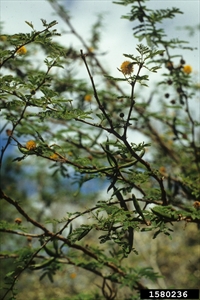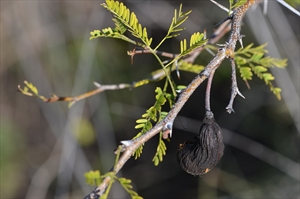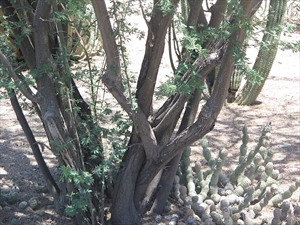- Worldwide distribution. In Australia, Cook Islands, Fiji, French Polynesia, Guam, Kiribati, Nauru, New Caledonia, Northern Mariana Islands, Palau, Solomon Islands, Vanuatu.
- Important invasive shrub, small tree, forming thickets, impeding mustering and access to water. Thorns prevent creational activities. Tolerant to range of soil types of different pH. Prefers full sun to shade, low rainfall (but tolerates high if long dry season), resistant to drought and fire. Common in natural and managed grasslands, along creeks and river banks, disturbed areas, cultivated agricultural land.
- Fast growing, up to 7m, thorny. Branches zigzag; leaves yellowish-green, 2-8 'branches', each with 5-20 narrow leaflets. Flowers, yellow, fluffy, 1cm diameter, fragrant, on hairy stalks from leaf forks. Seeds in pith of cigar-shaped brown pods.
- Spread: seeds dispersed by livestock; deliberate introduction for fodder crops, and for scented flowers.
- Biosecurity: fodder species, ornamental, ingredient in perfume.
- Biocontrol: none.
- Cultural control: hand-weed, dig out, slash (follow-up with herbicide). Clean machinery/vehicles; quarantine livestock 1 week between infested and ‘clean’ pastures. Sheep, goats and camels will eat it.
- Chemical control: in Australia, diuron; metsulfuron-methyl; glufosinate-ammonium; dicamba; tebuthiuron; aminopyralid + metsulfuron-methyl. Minor use permits have been given for: clopyralid; fluroxypyr; and triclopyr.








